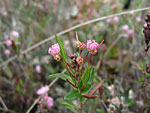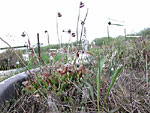By Mary Losure
Minnesota Public Radio
July 8, 0000
Not far from Northern Minnesota's Boundary Waters canoe country lies another wilderness where almost no one goes. It's called the peatlands, and it covers one third of Northern Minnesota. It's too soggy to farm. The few trees growing there are too stunted to log. But these long-ignored lands may hold one key to our future in the age of global climate change. If the world's vast peatlands flourish in warmer temperatures, they could help put the brakes on global warming. If they wither, they could greatly aggravate the problem. No one knows what will happen, but in northern Minnesota, scientists are seven years into some of the first experiments to find out.
| |
|
|
|
||
Worldwide, the wilderness of peat stretches across Alaska, Canada, Siberia, and Scandinavia, encompassing more than 9 million square miles. It's home to swarms of biting insects, an array of unique and fascinating plant life, and little else.
University of Minnesota biologist John Pastor says most people have no idea how important peatlands are to the world.
"A peatland is a very large wetland, with about a meter or more, sometimes up to three or four meters of peat; partly decomposed or undecomposed organic matter, and half the weight of that peat is carbon," he says.
The carbon in the peat comes from carbon dioxide. Mosses and other peatland plants take carbon dioxide out of the air and store it in their tissues. When the plants die, they don't rot, because the climate in the peatlands is too cold and wet.
"And so all that carbon, rather than being returned to the atmosphere as carbon dioxide from the rotting process, becomes stored in peat. And about one third of all the carbon in all the topsoil in the world is in peatlands. Even though worldwide those peatlands only occupy three percent of the worlds surface, they store 33 percent of the world's carbon," says Pastor.
But now, the earth's climate is changing, because people are putting vast amounts of carbon dioxide into the atmosphere. They're doing it by burning fossil fuels --products from oil fields that were themselves once ancient peatlands.
"We're taking essentially what's very, very, old peat -- 300-million-year-old peat -- oil and fossil fuels, and burning it almost in the blink of an eye geologically, and putting it back into the atmosphere. So we're warming the climate; even the Bush administration admits that now. And so then the problem is what is that going to do to the ability of peatlands to store carbon?"
| |
|
|
|
||
It's a huge question. Can the world's peatlands thrive in a warmer climate, taking up more carbon dioxide and slow global warming? If peatlands dry and rot under warmer conditions, they'll release the carbon dioxide they've stored over thousands of years, speeding global warming. In other words, peatlands will either be a giant brake, or a giant accelerator on global warming.
The experiment to find out which is laid out in a field about three hours north of Minneapolis. One winter seven years ago, researchers went into nearby peatlands and dug out more than 50 circular patches of vegetation, each about six feet across. They sampled two types of peatland, one known as bog, the other called fen.
They moved the bog and fen samples, roots and all, to insulated plastic tanks where they could simulate conditions under various global warming scenarios.
Pastor shows a visitor rows of tanks festooned with heatlamps and sensors. "When we established all of these tanks, the depth of the peat was the same in all of them, and so the surface of the peat, or the moss in this case, was right at the surface of this tank."
Now, the bog samples have risen above the surface of their tanks, like muffins rising in the oven. "What has happened is the bogs have gained carbon. It's gained this much carbon in seven years. And the fens have lost carbon. If you look at the some of these things, the surface has actually sunk down below," Pastor says.
| |
|
|
|
||
What that means is that one type of peatland -- bog -- takes up more carbon dioxide under warm conditions, while another type of peatland -- fens -- releases carbon dioxide.
"If it (the world) were all fens, that would be bad. So the question is: how many bogs and fens do you have? That we don't know. What this research has done is point to the need for a global inventory, a better global inventory of peatlands," according to Pastor.
But that inventory is still a long way away. Canada has done one for that country's peatlands, but the breakdown in the rest of the world is largely unknown. In this country, NASA is doing satellite surveys of wetlands as part of an effort to understand global carbon cycles.
Diane Wickland, manager of the agency's terrestrial ecology program, says NASA is interested in a peatlands inventory, but right now the agency doesn't have the technology to distinguish bogs from fens from space.
"Ten years from now, we might well be able to do something like that, but we need to do a lot of research to evaluate the potential of some of these new technologies," she says. "We did some very preliminary work with an airborne hyperspectral sensor, and did have some success in separating bogs from fens in that analysis. So it's possible getting a sensor like that in space, maybe in combination with another sensor, might do the trick."
In the meantime, Pastor and other scientists are developing computer models of how bogs and fens work. Someday, perhaps within the next 10 years, he hopes to combine the pieces of the puzzle.
"We will take our computer model, or other people working on similar computer models, we'll then run these computer models across the satellite image, so to speak, to try and simulate the dynamics of the peatland worldwide. So it's a big effort; it's a huge effort."
"I wonder if by the time we come up with the answer it won't be too late, because of the way the world is going. But what can I do? I could either just give up, and say 'the hell with it,' or I can just say, 'alright, this is what I can contribute.' I can contribute data, and probabilities, and some kind of answers, some kind of guidelines, some kind of tools to help people make the decisions," Pastor says.
In any case, Pastor says the experiments have revealed more about a fascinating and little understood part of the natural world. In one of the tanks, to his surprise, a rare bog orchid has flourished in the artificially warmed air.
Whatever comes of the experiments, he figures in 10 years maybe we'll figure out how peatlands work, and for its own sake, that's worth knowing.
More from MPRMore Information



